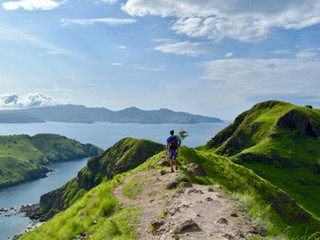Mother of Dragons: Flores & Komodo National Park, Indonesia
- tangio
- Jun 7, 2020
- 13 min read

We are probably the first people to ever go directly from staying at a luxurious 5-star resort one night, to a shared 12-bed hostel dorm the next night.
We did it for the views.

Off the shores of Labuan Bajo, a small gateway town located on the western tip of the wild island of Flores, in Indonesia’s southernmost province of East Nusa Tenggara, the fishing boats bob to the booming serenade of the mosques’ five daily calls to prayer, and the sunsets cast a luminous glow over the string of neighboring emerald islands each night. Few places offer a better view of both of these beautiful cycles than on the third floor of Ciao Hostel, in the open-air dorm room sitting in the hills above the town. Here, our twin beds faced the sea, without so much as a windowpane in our way—the entire side of the room along the water is open to the elements.
Of course, this also meant there was no AC in the extreme humidity and heat (which barely dropped at night), and no way to keep out the mosquitoes, against which the provided mosquito nets draping over our beds were practically useless because they had so many tears in them. And, we didn’t really want to cover our bodies with sheets because it was so hot.
But it was all fine, because, the view.
This—the subconscious pardoning of less-than-adequate conditions because the beauty and adventure around us were so striking that they more than made up for it—would turn out to be a theme throughout our time on Flores and the surrounding Lesser Sunda Islands.

Take, for example, the boat that served as our home and activity hub for our two-day trip throughout Komodo National Park. For years, we had been looking forward to seeing Komodo Dragons, found nowhere else in the world but on the islands of Komodo and Rinca off the western coast of Flores. We had wanted to experience this on a multi-day sail through the islands from Lombok to Flores, but unfortunately, at this time of year, the waters were still too choppy for that long route, so the next best thing was a shorter, roundtrip sail in and out of Labuan Bajo. Nevertheless, we were still very excited that morning to take the two-day trip—that is, until we stepped onto our boat.
Imagine a child building a boat out of corrugated cardboard, using saran wrap for a roof and newspaper as the deck, and then setting it on top of a puddle, hoping that it stays afloat. Now imagine that thing life-size—that was our boat. Naturally, it was named the Mona Lisa III, though there was nothing artistic or priceless about it. What was priceless, however, was our time spent on her worn planks. We had come to see the Komodo Dragons, but with the Mona Lisa, we left with so much more.

On the first morning, after choking through the exhaust spewed out at port, we cruised out for a few hours over rolling waves, ultimately entering Komodo National Park, surrounded by a ring of low-lying green islands. (Even though the Mona Lisa had masts, we never actually hoisted any sails and ran entirely by motor power.) During this time, we started to get to know our fellow travelers on board—we were about 28 in total on the small boat, including four Brits, four Irish, four Polish, three Italians, three Indonesians, an American/Russian couple, one Argentinian, five local staff, and the two of us. Over the next two days, there became a very clear divide between those who loved all the quirks of the boat and the trip (the “young fun group”), and those who did not (the “non-smiling group”). Needless to say, we befriended the young fun group (even though we were likely the oldest ones in it) and came to treasure the foibles.
Our first stop was Rinca Island, where we had our first encounters with the dragons! To protect us, we were led on a nature walk by park rangers carrying wooden sticks shaped like a “Y” at the end, which are supposed to hold back the heads of the giant lizards if they attacked. We questioned whether a mere stick would be effective, but it turns out we didn’t have to worry—the midday heat apparently makes the dragons just as lazy and tired as humans, and the 15 or so that we saw did not seem in attacking mode, barely lifting up their heads to acknowledge us as we walked by. Perhaps that was for the better, as some of them were up to ten feet long and very thick and strong, their massive armored hands and feet waddling from one shadowy resting spot to the next, while their long, forked tongues slithered in and out of their mouths. Komodo Dragons use their tongues to detect and smell, so it is a navigational tool more than a hunting weapon, but it still makes them look like a hungry predator looking to eat us! In fact, we heard multiple times that their sense of smell is so strong that women on their menstrual cycle are not allowed to come on the trip at all, as the dragons would smell the blood and attack humans, endangering the entire group. Fortunately, we were not able to validate this rumor. But Komodo Dragons are indeed carnivores—eating birds, deer, and even buffalo that are bigger than them, which they can take down with their venomous bite—as well as cannibals, often eating younger, smaller dragons—the species survives because the young ones can climb trees in order to run away from their hungry adults.
For an initial moment, we felt like we were in a mix of Jurassic Park and Game of Thrones, with these seemingly prehistoric dinosaur-like/dragon-like lizards wandering around us. But before long, they actually became fairly uninteresting, just lying there baking in the sun. A million photos later, the group continued with our hike through Rinca, enjoying an expansive view of the islands from the top of a viewpoint, and then said goodbye to our first set of dragons.

As intermission, we landed at Pink Beach, a small enchanted island cove with crystal pink sand and an underworld of colorful coral, seaweed, and fish in clear turquoise waters. It was one of the most rewarding snorkeling sessions we’ve ever experienced. It was also here where the line between “young fun group” and “non-smiling group” began to show itself, with some of the latter asking why we even bothered to get into the water…

The day capped with a twilight visit to Komodo Island, where we embarked on another nature walk with park rangers and came across more dragons. This time was a bit more picturesque—the dragons were sitting along a beautiful beach (they can swim, we learned!)—and a bit more exciting, because they were more active as the sun began to set and the air cooled. We even got to follow one as it approached a deer, thinking that we might get to see it catch its dinner, but it turns out that he/she just gave the deer a good stare-down before moving on. Like the deer, we shared a similar stare-down with another dragon, one who looked to be older, her scaly skin aged and her eyes wise and ancient. These protected creatures look so primordial that looking into their eyes felt like looking through a portal across time; in that moment, the entire earth’s history could have hung in the space between us, with Komodo as the land before time.
As the sun set on the day, we bid farewell to the dragons. Fortunately, though, it would not be the last of giant wildlife.
That night, we anchored in a nearby cove, ate a mediocre dinner (and not enough for 28 hungry bodies!), and spent the night hours hanging out on the upper deck with the young fun group over Bintang beers and one of the Italian’s techno music selection. As we retired to bed, we admitted to the group that we were scammed into paying extra for a “private cabin” on board, while every other person—even the British couple in their sixties—would sleep in the giant open-air deck underneath the saran-wrap tarp, each futon mat touching the one next to it, like a massive slumber party. Truth be told, we think they got the better deal, as our “room” was more like a coffin for two, located on the bottom deck with no windows, next to the kitchen and engine room, where we smelled the exhaust and heard the staff stay up much of the night. It didn’t even offer any comforters or sheets, probably because it was so hot and stuffy in there that no reasonable person would ever use covers. And it’s not like we had a private bathroom or anything—the entire boat shared two holes in the deck as toilets. We wanted to sneak up to sleep on the open-air deck, but every inch and mat were claimed. The next morning, though, we heard that the Polish group had dragged their mats down to the lower deck to try to get more space, while many others got wet when the typical rain squall came through in the middle of the night, because, shockingly, the tarp did not keep everyone dry, even when it was pulled down over the sides. They wished they had been in our covered coffin, while we wished we had been at their breathable slumber party. No one had slept well.
Tired and under-nourished, we all got ready for an early morning hike up Padar Island. One does not want to start climbing Padar any later than 8am, as it gets hot, with zero shade under the blazing sun. In fact, our crew had tried to get us there by 5am to both catch the sunrise and avoid the heat, but when they checked the sea at 4:30am, the conditions were still too choppy, so we had to wait till 7am for the winds to die down. As before, we immediately forgot about any discomfort from the lack of sleep and scant food as soon as we laid eyes on the iridescent hills of Padar. Part of the Komodo archipelago, Padar was once home to Komodo Dragons, which have since become extinct on the island, but it is still home to some of the most stunning volcanic mountains and ocean bays we have ever seen. Four deeply concave bays form the island’s fringes, like white sand halos crowning the sheer rugged mountains that rise up suddenly from them. A steep rocky path led us on a short but incredibly sweet hike up to the peak at 238 m/781 ft, with unbelievably stunning views that got better and better—and sweatier and sweatier—with each step up. We and the young fun group spent time frolicking around the cliffs up top, rendered speechless at the panoramic sight of islands surrounding us on all sides, stretching toward the horizon, embraced by blue-green seas. Meanwhile, we’re pretty sure a couple in the non-smiling group got into a big fight up top—not sure how you get into a fight while staring at a view like that. On an amazingness-per-foot-of-elevation-gain basis, the Padar Island hike is among the best we’ve ever done.
Afterward, drenched from sweat, nothing felt more refreshing than jumping and flipping off the boat and swimming in the water. With the above-sea level portion of our trip done, it was time to go below. The Mona Lisa III then set out in search of manta rays, which are plentiful in this area well known for some of the best dive sites in the world. Our crew had warned us that as soon as they saw a manta ray, we would need to be ready to jump into the sea immediately because the currents are fast, but few of us realized how quickly they really meant. Fortunately, the two of us were among the earlier ones to don our flippers and wait for the cue. Suddenly, in the middle of nowhere in open sea, the captain yelled, “Here!!” Not a moment later, we heard the splash of the crew leader diving in, motioning all of us to follow him.

Caught off guard, there was a scramble on board as we hastily pulled the snorkel over our faces and leapt over the edge of the boat, swimming frantically after the crew leader. Only about six of us got into the water fast enough, and within seconds, we were carried away from the boat by the fast-moving current, putting us right above a gigantic manta ray below us! Spanning about fifteen feet wide, the gentle manta looked incredibly graceful as its enormous fins barely had to move to propel her dance across the sea floor—but it was deceivingly fast. We had to pump our legs and flippers aggressively just to keep up. But it was worth it, as we shared what felt like a long silent waltz with the manta ray, allowing us to appreciate this strange beautiful creature’s elegance (it was probably only five minutes in real life, if even). She then took off into deeper depths, leaving us behind. We popped our heads out of the water, looked around, and only then did we realize there were only a handful of us. Looking back toward the boat, which was now quite far away, we continued to see a scramble of chaotic activity, with some folks still trying to figure out their snorkeling equipment, while others who had jumped in just a tad later than us had missed the current, leaving them too far away from us and the manta ray. Then there was a member of the non-smiling crew, who chose not to get in at all. “Why do you need to go in? You can see them from the surface,”—why did he even come on this trip?!
We went on the search again, and in a few minutes, the crew had spotted another area where several manta rays were hanging out. This time, almost everyone was waiting in anticipation and ready to jump in. When the time came, we all sprung off the boat again, and right off the bat, saw two large manta rays swirling below us. One broke off and started swimming away, with about twelve of us on her tail. We swam fast and hard to keep up, following her lead, watching her fluid movements, and enjoying the peaceful solitude that comes with being mostly underwater, the only sound the occasional muffled underwater squeals of excitement from our fellow snorkelers. After what again felt like a special time spent with this manta before she left us, we swam all the way back to the Mona Lisa III, saving just enough energy for one last sea adventure.

Our last stop was in a protected bay where sea turtles abound. A final swim and snorkel put us face to face with many of these large turtles, their brilliant shells reflecting a prism of colors through the sea-filtered sunlight as they swirled in slow motion circles around us. We hung out with them until our bodies got cold in the water, but as we got back onto the boat one last time, our hearts were warm and full from the intimate time spent with all these sea giants. In some ways, even though the Komodo Dragons were more unique, the expectation of seeing them made them somewhat less delightful than the unexpected encounters with the manta rays and sea turtles, the beauty of Pink Beach, and the spectacular Komodo archipelago as a whole.
On the three-hour sail back to Labuan Bajo, we all realized we were exhausted, having barely slept the night before and then expended a ton of energy that morning, hiking, swimming, and snorkeling heavily. Everyone found a spot somewhere on various decks, sprawled out, and promptly fell asleep, warm under the high sun and calmed by the lullaby of the Mona Lisa slicing through water.

Suddenly, we were awoken by a lurch and a screeching mechanical noise coming from below. The boat stopped moving, which then caused us to rock back and forth in the grip of the waves, immediately eliciting seasickness reactions. Everyone started stirring and wondered what happened. A crew member jumped into the water and swam below the boat to check out the situation. We think that something caught in the propeller, causing the motor to break down (though we never got any details about what happened); the crew spent some time trying to fix whatever it was, to no success. There we were, within sight of Labuan Bajo’s marina, unable to complete the final five kilometers. Ironically, for the first time in two amazing days, the sourface guy finally cracked a cynical smile. We were also laughing, thankful we had even made it this far, as we couldn’t believe something like this hadn’t happened earlier given the state of the boat. After flirting for a minute with the idea of swimming the whole distance back, another cardboard box-boat soon rolled up next to us and threw us a line; it was the Mona Lisa II (no joke!), who towed us back to shore with nothing more than a thin rope.
Once back in Labuan Bajo, we had two more days on Flores, and spent our time getting to know some of our new friends better, meeting up again with the Irish group and a couple of the Italians, as well as meeting news ones at our hostel. All of Labuan Bajo town is walkable in 15 minutes, so it was less exploring and more ambling—watching scenes of local kids playing sepak takraw (an amazing kick volleyball game that brings out some of the fanciest footwork we’ve ever seen), enjoying the sunset radiate off tin roofs, and going to the small portside fish market for dinner both nights, where we picked our choice of red or black snapper and calamari among a slew of other fresh seafood, and had it deliciously seasoned and grilled to order.
On our last day in Flores—and thus in Indonesia—we joined up with four new friends from our hostel to head to Cunca Wulang Waterfall, located about a 90-minute drive away, up winding mountain roads deep in the lush jungles of Flores. We had all decided to go fairly last minute, and despite a nauseating ride over, ended up having a spectacularly fun afternoon of hiking, [small] cliff jumping into the river, and swimming upstream toward the thunderous falls of Cunca Wulang, again testing our arm strength as we battled against the strong waterfall current. Not surprisingly, we most enjoyed getting to know our fellow travelers—a girl from the Netherlands (about the hundredth one we’ve met on this trip!), a guy from Israel, and two Americans who had moved to Israel to join the Israeli Army. Because Indonesia does not allow Israelis to visit, the Israeli had a passport from, out of all countries, Malta (while the Americans simply used their U.S. passport). Despite all “coming from” the small island of Malta, they did not know each other until recently, but it felt like all of them were longtime friends, sharing rooms and recounting memories in the traditional Maltese language of Hebrew. After just a few hours with them, it was easy to see why, because we also felt like we had known them forever, joking and talking with ease, sharing beers and taking photos as if we were all on vacation together. Hilariously, our two required guides for Cunca Wulang Waterfall—locals named Ricardo and Alfonso, a vestige of the Portuguese influence on Flores from the 16th to 19th centuries—also snapped what literally felt like hundreds of photos of us all day, as if they were paparazzi. As a result, we have a disproportionate amount of photos with these friends, despite only hanging out with them for one full day.
After the one well-documented day, we bid the Maltese + Dutch farewell the next morning as they took off on the Komodo trip and we, sadly, got ready to leave Indonesia. As a sign of the times to come, our flights out from Flores to Bali, and Bali to Singapore, our next stop, kept getting canceled and rescheduled as flights were consolidated in the face of the coronavirus pandemic.
If traveling now feels like lifetimes ago on another planet, Flores was always a world apart.
Karen & Michael
February 29 – March 4, 2020, the islands of Flores, Komodo, Rinca, and Padar, Indonesia






























































































Comments